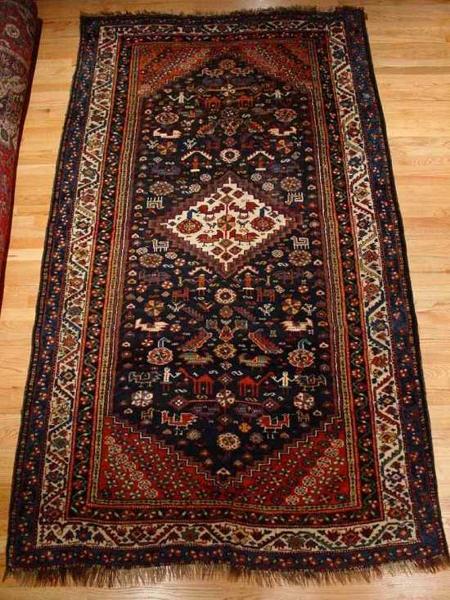
The Salon du Tapis d'Orient is a moderated discussion group in the manner of the 19th century salon devoted to oriental rugs and textiles and all aspects of their appreciation. Please include your full name and e-mail address in your posting.
Part 2: Alluring Luris, Denizens of the Zagros
by Patrick Weiler
Now we come to a larger Luri rug.

This rug has brown warps and wefts, possibly indicating a Luristan
provenance. It has 6 x 8 knots per square inch, again a low knot count
- a likely indicator of Luri weaving. This one is larger, at over 9’ x
5’, again about twice as long as wide.
Notice in this rug, also, there is a blue to brown abrash.
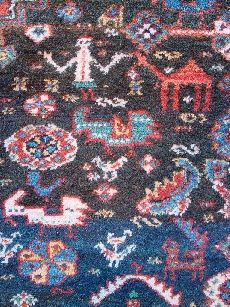
In this rug, the field is a deep blue until 3/4 of the way up. It then
changes abruptly to a dark brown. The change is hardly noticeable due
to the darkness
of both colors. There is a relief to the oxidized brown in most
of the rug, although this rug does not seem to be quite as old as the two
previous rugs.

Here you can see the brown wefts.
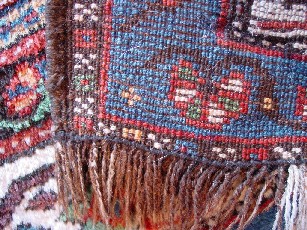
In these two photos you can see the front and back of one of the birds.
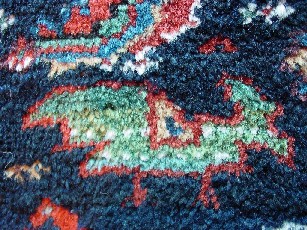
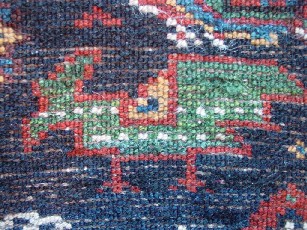
There are other birds with smaller birds on their back. This seems to be an ancient Luri design, perhaps coming from the famous bronzes.
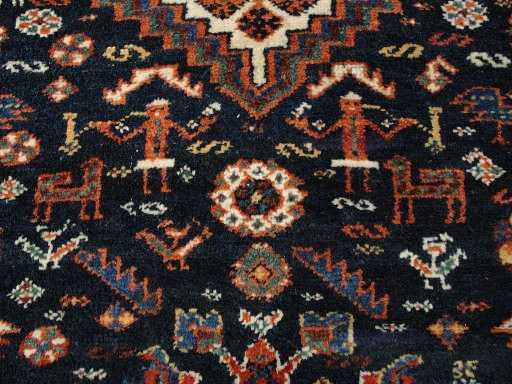
Another tribal culture utilizes an image of a large bird with other birds perched upon its back. The Senufo tribe of Africa uses a bird on a pole, called a Sejen, often with smaller birds on top, in some harvest and planting rituals. There is a Salon devoted to these interesting sculptures on Afro-dit (23).
This rug was not woven by a woman from a downtrodden, poverty-ridden culture. It bespeaks a wealth of camels, chickens and flowers; of a proud and successful tribe. The colors are vibrant, the pile is long, the handle is thick and meaty. Early in the 20th century the Lurs were still quite a vibrant, integral sector of the Persian empire. But times they were a-changin’. It was not long before the Shah, bent on subduing the strength of the tribes, subjugated the Lurs.
This is a very large khorjin (40" wide x 54" high).
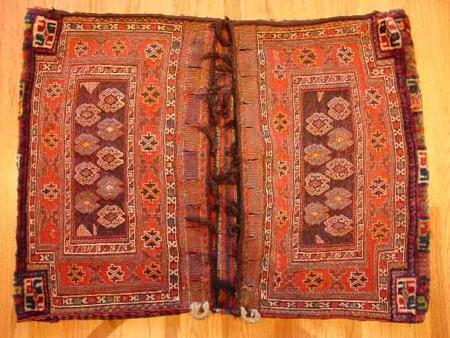
And the back.
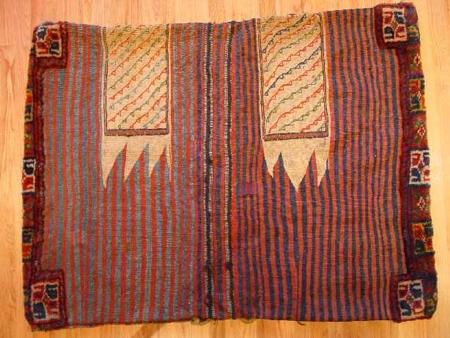
Jim Opie thought that this was a Baktiyari bag, not Luri, but did not offer specific reasons for the Bakhtiyari designation. Perhaps it is the regularity and neatness, rather than the usual haphazard weaving of the Luri’s. The pattern on the back is on wool wefts, a rather unusual occurrence, since most of these large bags have a cotton background for this area, although the white in the soumak designs is white cotton, not wool, which may be another reason for his decision. The pile is symmetrical, undepressed, with some red and some blue wefts.

A close up of the edge shows the goat hair overcast.
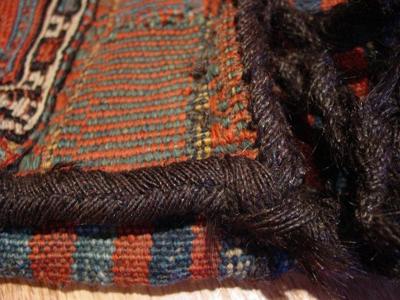
This closeup of the front shows the typical loose soumak weave and diagonal wrapping.
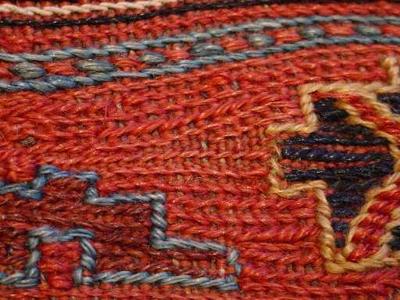
Some smaller Luri bags with the typical rosettes and latchook medallions are shown here.
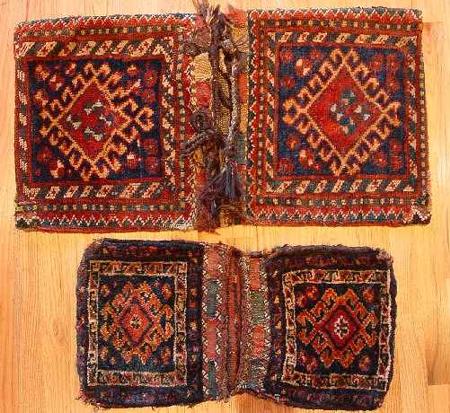
Here is a close up of the front of the larger bag. It shows an almost identical design to one of the long rugs above.
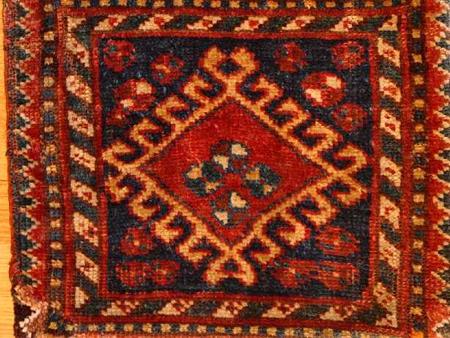
One common feature of both pile bags and rugs of the Lurs is the rosette. All three large rugs shown in the Salon have numerous rosettes on them. This bagface could be easily mistaken for Khamseh or Qashqa’i.
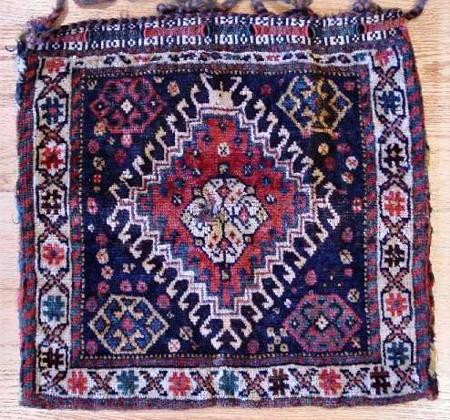
What makes it more likely Luri? For one thing, the “chromosome” border that is not entirely symmetrical. For another, the warps are goat hair instead of white wool.
Here is a chanteh front, seen in the earlier salon about chantehs.
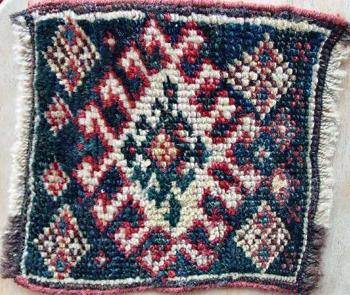
And a closeup of its back.
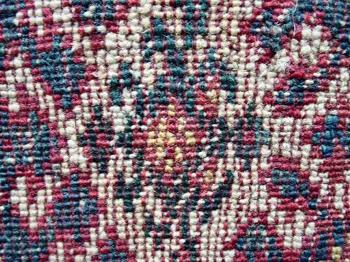
Again we see the lack of symmetry, the latchooks, red wefts and dark warps. I am sure that the weaver of this delightful piece was just as proud of it as if it were a full size Luri main rug.
Here is another bagface that could easily be assigned to Khamseh or Qashqai weavers.
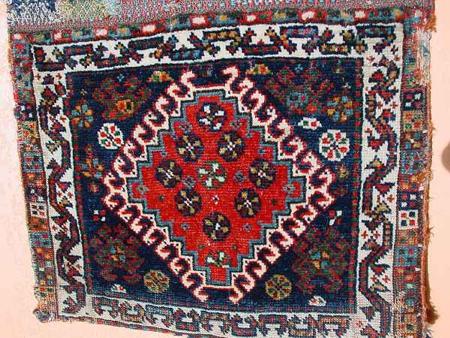
And a closeup of one corner.
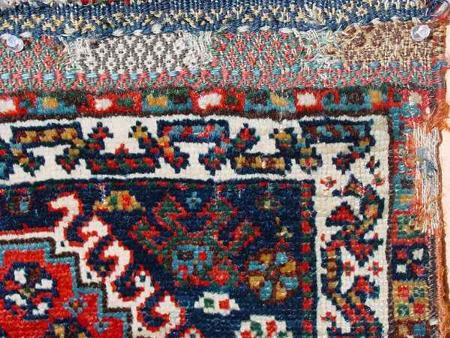
What makes it Luri instead? The warps are white, a Qashqa’i attribute. But the border, the aberrant latchook figures in the corners of the field and the rosettes all conspire to place this bag firmly in the Luri firmament. It is possibly from the Fars area, as it has been noted that the products of the Fars tribes are nearly indistinguishable from one another.
The Philadelphia Rug Society (24) also has a Luri bag in the gallery on their web site. It is a beautiful example of the colorful, delicate interpretation of traditional Luri design that makes these weavings so attractive.
This next photo shows a bag commonly known as a spindle bag, but what has also been called a ladle bag. It is big enough (10" x 17") to hold the longest ladle I own. It has a cotton foundation, except for black goat hair warps for two inches of the width of the back. The design is done in mostly 4/2 countered soumak, with smaller details done in 2/2 soumak, diagonal wrapping between the rows of design and complementary-weft weave borders. Notice the reciprocal diamond border similar to the larger khorjin above, and also the small crosses in the diagonal stripes are similar to the crosses in the main border of the previous bag.
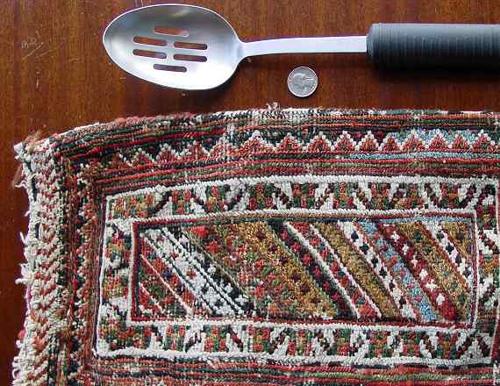
There were numerous small utilitarian bags woven by nomadic Lurs, many of which are not easy to identify as Luri.
QUESTIONS
There are some intriguing questions about Luri rugs. Why are there numerous Luri gabbeh rugs in a smaller format, but no “typical” Luri rugs that small? Why no “engsi” size Luri rugs? Are they all worn out? Do they exist, but we do not recognize them? Are there any Luri prayer rugs? Was their pre-Islamic background influential into the 20th century? Are there any Luri rugs in the “prayer rug” size? If not, why not? Were prayer rugs only made for commercial purposes and the tribal, nomadic Lurs had no reason to make them? Were the Lurs too poor to own prayer rugs? If so, how could they afford a large 10-foot long carpet but not a smaller prayer rug? Does this mean that the Long Rug format was woven by settled Luri weavers for the market? Opie says that the Luri lack of concern for strict symmetry in many of these long rugs indicates that they were not woven for sale, but states that the Lurs did weave for the market.
Were these long rugs made as part of a dowry? One
long rug for the new tent, one salt bag, one saddlebag? Could
it be that the “typical” Luri rug, of considerable size,
8 to 10 feet long, was only woven for the market, while their bags, gabbehs
and trappings were used internally? The overwhelming majority
of Persian tribal rugs extant were woven after the Western markets became
accessible to Persian weavers. Did the market
for rugs from western buyers influence the production of the Luri “long
rugs?